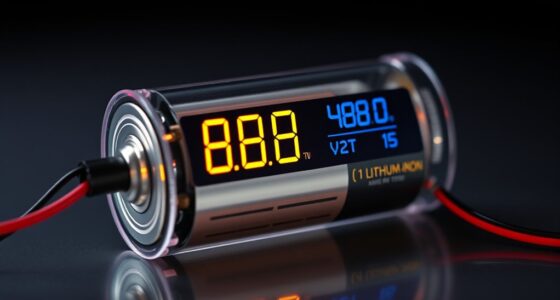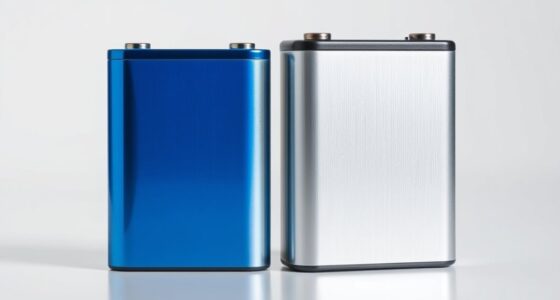Peukert’s Law explains why battery capacity isn’t linear; as you draw higher currents, the available energy decreases faster than expected. This happens because increased discharge rates raise internal resistance and cause voltage drops, reducing overall efficiency. The chemistry and age of the battery also influence how much capacity drops under load. If you want to understand the science behind these effects and how they impact your devices, keep exploring this fascinating topic.
Key Takeaways
- Peukert’s Law shows that battery capacity decreases as discharge rate increases due to internal resistance and electrochemical limitations.
- Faster discharges cause voltage drops and reduce the total usable energy, making capacity appear non-linear.
- Battery chemistry influences how significantly capacity drops under high loads, affecting the degree of non-linearity.
- Aging batteries have higher internal resistance, leading to greater capacity loss at higher discharge rates.
- Slower discharges allow batteries to deliver closer to their rated capacity, highlighting why capacity isn’t a fixed, linear value.

Peukert’s Law describes how the capacity of a battery decreases as the rate of discharge increases, meaning the faster you draw current, the less overall energy you can expect to extract. This concept is essential to understand because it explains why batteries don’t provide a consistent amount of power regardless of how quickly you use them. When you draw a high discharge rate, the battery’s internal chemistry doesn’t have enough time to fully respond, leading to a reduction in the available capacity. Over time, battery aging accelerates this effect, as older batteries tend to experience more pronounced capacity loss at higher discharge rates. As batteries age, their internal resistance increases, making it harder for current to flow smoothly. This resistance impacts the battery’s ability to deliver power efficiently, especially during rapid discharges. Additionally, battery chemistry influences how significantly Peukert’s Law affects performance, with different chemistries exhibiting varying levels of capacity reduction under high loads. When you use a battery at a slow discharge rate, you typically get closer to its rated capacity because the internal processes work more smoothly and efficiently. But when you push the battery harder, pulling more current in a short period, the effective capacity drops due to the increased internal resistance and the electrochemical limitations highlighted by Peukert’s Law. This isn’t just a theoretical issue—it affects real-world applications like electric vehicles, portable electronics, and renewable energy storage systems. If you’re relying on a battery to power a device that demands quick bursts of energy, understanding this relationship helps you predict how long the battery will last under different load conditions.
Battery aging further complicates this picture. As batteries get older, their ability to sustain high discharge rates diminishes. The capacity loss isn’t merely a matter of reduced total charge but also involves increased voltage drops and decreased efficiency under heavy loads. This means that an older battery might deliver less energy than a new one at the same discharge rate, and the gap widens as the battery continues to age. Knowing how discharge rates influence capacity and how aging impacts performance, you can better manage your batteries, optimize their usage, and plan for replacements before critical failures occur.
Frequently Asked Questions
How Does Temperature Affect Peukert’S Law?
Temperature markedly impacts Peukert’s law through thermal effects that influence battery capacity and discharge rates. As temperature drops, your battery’s capacity decreases and internal resistance rises, making it seem like Peukert’s exponent increases. Conversely, higher temperatures improve capacity but can accelerate aging. To maintain accurate capacity estimates, you should use temperature compensation, adjusting your calculations based on current thermal conditions, ensuring your battery management system remains reliable and safe.
Can Peukert’S Law Be Applied to All Battery Types?
They say every rule has its exceptions, and Peukert’s law is no different. You can’t apply it universally to all battery types because of varying battery chemistry and application limitations. It works best with lead-acid batteries, but for lithium-ion or other chemistries, the relationship between discharge rate and capacity isn’t as predictable. So, always consider the specific battery chemistry and application limits before relying solely on Peukert’s law.
What Are Common Misconceptions About Battery Capacity?
You might think battery capacity is straightforward, but battery myths often cause capacity confusion. Many believe batteries always deliver their rated capacity regardless of load or usage, which isn’t true. In reality, factors like discharge rate and temperature affect capacity. Don’t fall for capacity myths—understanding these nuances helps you better manage your batteries and avoid overestimating their performance, especially during high-demand situations.
How Does Peukert’S Law Influence Battery Lifespan?
Coincidentally, Peukert’s Law reveals how high discharge rates accelerate battery degradation. When you draw more current, your battery’s capacity drops faster, reducing its lifespan through increased wear and fewer charge cycles. This means that pushing your battery hard shortens its overall life, making it vital to manage discharge rates. By understanding this, you can optimize usage, extend battery lifespan, and avoid premature failure caused by rapid capacity loss.
Are There Practical Ways to Mitigate Peukert’S Effect?
You can mitigate Peukert’s effect through effective battery management by avoiding excessive loads and maintaining consistent discharge rates. Load balancing helps distribute power evenly, reducing stress on any single cell and extending battery life. Use smart chargers and monitor your battery’s health regularly. By controlling how and when you draw power, you guarantee better performance and longevity, minimizing the impact of the nonlinear capacity decline caused by Peukert’s Law.
Conclusion
Now that you understand Peukert’s Law, it’s clear that battery capacity isn’t a straight line. Pushing your battery too hard can backfire, leaving you high and dry when you need it most. Remember, don’t put all your eggs in one basket; knowing how your battery behaves helps you make smarter choices. Keep this knowledge in your back pocket, and you’ll avoid surprises, ensuring your power source keeps up when it counts.










